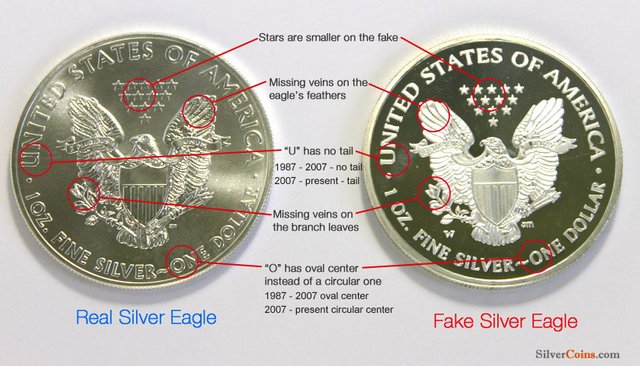Introduction to Silver Stacking: How to Spot a Fake!
This is likely getting a bit deeper then introduction content but I know this one was requested so I'll tackle this one. There are lots of ways to know "for sure" but at the same time forgeries are also getting much much better as well.

Source-Also a great read with more details
First I'm going to say if it's too good to be true, it probably is and be cautious
Especially if your buying online somewhere or privately, or Ebay. They can fake just about anything, from modern numismatics like coins from the Royal Canadian Mint, to generic bullion or even collector coins and graded slabs. I've even seen forgeries of popular privately minted semi-numismatic rounds. Nothing is safe!
With that being said, if your new I would once again recommend sticking with reputable established dealers or very trusted sellers.
I'm going once again keep it more or the quick side, it's easily a full post on each method, and there's lots of great YouTube videos and resources available.
Look at them
This is very imprecise but you can usually tell a fake or at least feel a bit suspicious. Usually the finish isn't totally right and some minor details are missing or different. There are lots of books and guides that will walk you through some common forgeries. Again this comes with experience and it's not going to help you much starting out.
Precise Measurements
The method is just to weigh them and measure them. Everyone should have a good gram scale to take a quick measurement. 1 oz is 31.103 Grams and bad forgeries are usually way off. Even minted coins will have some minor variations, but a bad forgery will be way off. This is the same for the width and diameter. If you have yourself a good set of calipers you can often detect some differences. There is some variation in planchet diameter and thickness depending on the coin, but most are listed online to confirm. Measurement alone will not get you very far since most forgeries are much more sophisticated than this, but you'll pick up a few for sure.
Sound
If you have a good ear, you can always trust a "ping" test. I'm convinced I'm tone deaf and can't notice a repeatable difference, but it does matter just how you strike it. Pure silver is said to have a delectable "ping" sound when it's struck. Many people suggest striking it against a known genuine coin and listening. Like I said I for the life of me don't feel comfortable with this, but many people swear by it.
Magnetism
Silver is not magnetic, so this is another quick check and a poor forgery will often be magnetic and stick to a magnetic if it is just plated copper or other magnetic alloys. Beyond this is gets a bit technical but silver has dimagnetic properties, this is some real fancy physics stuff, but it does kind of react to a magnetic. This is pretty damn hard to see but people have made "coin slides" that can be used to test for fakes. It's not perfect either but another great tool.
Here's a video showing this I found on YouTube.
We'll take a break here and I'll once again suggest getting the tools above and check before you buy if your going to be buying privately at flea markets or local classifieds and such. Coin shows are usually much safer since those dealers usually have a reputation to uphold, but be leery of new vendors without an established reputation.
If you want to be really sure
I'd say those first few tests will do you pretty good spotting some fakes, but once again many are much more sophisticated than that. This is where you need to get into more advanced testing such as the ones below.
Acid test/destructive tests.
There are commercial acids that can be applied to coin surfaces to that will react a certain way with pure silver. Of course if it is plated and thick enough it will still react appropriately. So often when doing an acid test it's suggested to file down a portion or snipe or cut some. Of course these will destroy any premiums, but if you really need to know if it's real this will work. Just cutting it in half will also often reveal an obvious core of a different metal. You can also melt it, which will be apparent pretty quick,especially if your in the habit of melting silver, you'll be able to tell.
Specific Gravity
This one is based on another fancy physics principal regarding the density and atomic mass of pure silver. This one really works and can be pretty precise and doesn't need anything too fancy to complete. Essentially you weight a coin in air and also weight it suspended in water and do some math and compare. The video below explains it more and there are a lot of other online resources as well.
Electromagnetic Signature
This can be done very reliably by some fancy commercial machines that many big dealers or bullion stores have. If your LCS has one and your on good terms you can sometimes get them to scan them for you. There are household machines that cost around $800. The most popular one is a Sigma Brand Machine. I've watched a few videos of them in action and they are very quick and reliable, but of course also quite expensive. I'll post a video below with one in action.
This is a big one and like I said some more advance stuff, but there really are lots of fakes out there if you are not careful

Footer by @bearone

Bravo! Bravo!
Full on stand up out of chair and slow clap for this motherfucker, Motherfucker!
Great post Phil! — Sharing the wealth 😎👍
Thx man, That's an overwhelming vote on confidence.
Always good to keep the people informed of this, I was burnt once but I also knew it was a risk buying.
I'm sure I have a few fakes hiding in there as well.
You have collected your daily Power Up! This post received an upvote worth of 0.34$.

Learn how to Power Up Smart here!
Here is an AMAZING resource for many hundreds of varieties and examples of fake bullion:
https://www.fakebullion.com
The owner is also owner of the coppercave retail site. He has done tremendous work at building up the library of actual fake bullion examples floating in the market.
A definite resource!
Hope this helps!!
Great work on this series so far @phelimint! Keep it up!
Peace
Copper is also diamagnetic so unfortunately a good copper coin that is silver plated will behave very similarly to a real silver coin.
Like you said the easiest/safest bet is to just buy from reputable dealers!
Yeah, so many of these methods aren't perfect and some forgeries are so good. It's definitely worrisome out there.
If its too good to be true...
Exactly. I once saw a Morgan head in an Afghan market for $1....I was tempted but thought "this just doesn't feel right". It was highly likely it was a fake. Now I kind of wish I had bought it just as a souvenir!
Yeah, my buddy @ejr almost bought some too good to be true coins in a German market recently too. There's lots out there for sure.
Thanks Phel! Good stuff! Glad I asked because I never would have known any of this!
Any last requests before I close the series?
Hi Phelimint, have you ever used The Fisch or The Ringer. https://www.thefisch.com
They both seem like very good tools to have in the counterfeit testing toolbox.
The Fisch
The Ringer
Haven't seen either man, thx for letting me know. I'll have to check them out.
Excellent post ! Covered all that a collector must know about fakes. My scale is my best friend and I love the ping of pure silver . I have just bought in Ebay a Panda for $5. It will come from China. I know that is a fake but I wanted to have one just to compare with my nonfake Pandas.
Yeah, that's defo a fake, I have a couple for comparison too.
Wow. Some cool methods I've never tried. As always excellent work!
Yeah, lots of ways, there's a few other's as well, that are a bit too impractical, I tried one trying to watch and Ice cube melt, since silver is much more superconductive than other metals.
Wow, learned a lot from this post! Particularly, I didn’t know what to look for on the back of ASG. Thanks man.
If you click that source link, they have another pic for the reverse too.